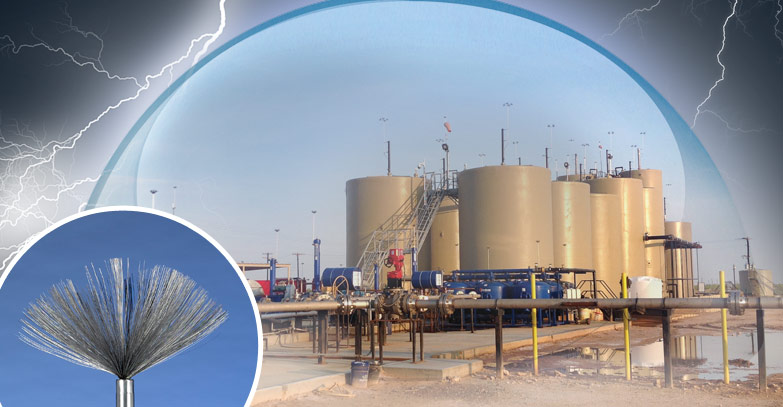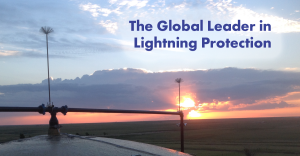STATE-OF-THE-ART LIGHTNING PROTECTION FOR HIGH-TECH INDUSTRIAL FACILITIES
Steve: One of my clients operates a large chemical plant on the Mississippi Gulf Coast. Because of its location, lightning has always been an issue for them. They could live with the limited amount of damage to equipment, but reliability issues, up to and including plant outages, were more than they could tolerate.
Twenty years ago, we began investigating lightning protection technologies applicable to this type of facility. We looked at conventional lightning protection as described in National Fire Protection Association NFPA 780, Standard for the Installation of Lightning Protection Systems.
Bruce: I have served as a principal member of NFPA 780 for more than 25 years. If you look at this standard, you will find that it was written years ago, back in the days of wood barns and homes, and well before microprocessors were invented. As such, the standard is designed primarily to prevent fires in wood structures by conducting the energy of a lightning strike around the structure to ground.
Steve: However, fire is not a concern at an industrial facility. These plants consist primarily of closed process vessels supported by steel frames. Lightning is highly unlikely to cause a fire. The real issue is outages caused by damage and disruptions to microprocessor-based equipment. Even a nearby lightning strike generates sufficient electromagnetic energy to disrupt control systems. We needed a system designed to actually keep this plant operating.
In our experience, lightning protection is a combination of grounding, surge suppression and structural lightning protection. This plant is grounded through a grid system. It is regularly inspected and tested, and is in good shape. It more than meets the requirements for structure grounding and for providing a reference ground for microprocessor-based equipment.
As part of an upgrade, we installed surge suppression on the AC power distribution system and at individual loads. We also looked at the SCADA system. We had one particular transmitter at an outflow into a nearby bay that gave us fits every storm. We definitely protected that circuit, along with other historically problematic circuits. Because of the vast number of circuits, it was not economically feasible to protect each one. Instead, we installed protection on the basic systems, then on each problem circuit as an issue arose.
However, we still experienced lightning problems. What we needed was a system that would do some good for the entire plant. Through our attendance at industry trade shows, we became aware of the streamer-influencing technology of Lightning Master Corporation of Clearwater, Florida.
Bruce: Conventional lightning protection systems are designed so that the lightning rod (air terminal) becomes the preferred lightning attachment point. To do so, the lightning rod has to act to attract the strike to itself in preference to surrounding objects.
Immediately before a lightning strike, stepped leaders propagate downward from the storm cloud. When they reach to within 500’ or so of the ground, their electrical attraction begins pulling streamers of ground charge from objects on the surface of the earth. Whichever streamer reaches a stepped leader first completes the lightning strike. Therefore, whichever structure emits the best streamer wins the competition and becomes the attachment point of the lightning strike. Lightning rod point shape and other factors can influence their streamer formation properties. In fact, the conventional lightning rod industry is presently trying to change the standard to require the use of rounded-tip lightning rods, as they better attract lightning. Modern plants are monitored and controlled by microprocessor-based equipment. The last thing you want to do is better attract lightning anywhere near a microprocessor.
Steve: The Lightning Master system appealed to us because, unlike conventional Franklin-type lightning rods, it offered the possibility of delaying streamer formation thereby reducing the likelihood of lightning strikes to our plant and reducing plant downtime.
Bruce: A traditional lightning protection system consists of three components: the lightning rods, the main and down conductor system, and the grounding system. A process plant, by its nature, already has these components. The structural steel is sufficiently thick to serve as the lightning rod (strike termination device). The structural steel acts as the conductor system, and the plant is already grounded with an extensive grid system.
Steve: According to NFPA 780, our plant is self-protecting and requires no additional lightning protection. Therefore, there was no reason to install a conventional lightning protection system. However, based upon our history of lightning damage, it obviously was not self-protecting in spite of what the standard said, so we needed to do something unconventional.
During the consideration process, we did a lot of research, contacting existing users of Lightning Master systems. We were quite impressed with the user support. Based on that and the desire to institute best practices at our plant, we went ahead and installed the Lightning Master system.
Bruce: We installed our streamer-delaying air terminals atop all plant structures, just as you would install conventional lightning rods. We added no conductors, and did not change the grounding system. In fact, we could not even get a permit to penetrate grade, for the obvious reasons. Our system uses NFPA 780 as the design standard for determining the layout of the air terminals. The air terminals we provided are UL Listed, although that is not an important criterion for industrial users.
Steve: The improvement was immediate and dramatic. The system works so well that we could quickly identify problem areas. One area in the plant has a highly corrosive atmosphere. This caused rapid deterioration of the air terminals to the point at which they were no longer effective, and problems started cropping up there. We investigated and identified the problem.
Bruce: NFPA and UL allow only certain materials to be used in a lightning protection system. Unfortunately, many of these materials do not hold up in an industrial environment. We were not happy with conventional lightning protection industry fittings, such as air terminal mounting bases, so we supplied fittings constructed of materials suitable for the environment.
We solved this particular problem by developing and installing titanium air terminals. As titanium was not a listed material, we submitted a proposal to the NFPA 780 committee to allow its use. The proposal was passed, so now we have at least one more weapon in our arsenal to offer industrial users. We are presently writing a proposal to modify UL 96 to allow materials suitable for use in industrial environments. Ironically, one of the arguments against allowing the use of titanium was its conductivity compared to copper. First of all, the difference in resistance over the length of a lightning rod is insignificant. However, what eventually carried the issue was the argument that you are better off with a slightly less conductive air terminal that is still there than with a slightly more conductive air terminal that has corroded away.
Steve: Although lightning accounted for relatively little of our total down time, we have noted an approximately 3% reduction in plant downtime with the installation of this system. This translates to substantial savings in lost production.
Is this system 100% effective? Of course not. We are talking about lightning here. However, we are running a business, not a research lab. Return on investment is usually measured in years. With this system, it is measured in months. That is an outstanding return on investment.
We understand that there is a lot of controversy over how, or even if, this type of system works. Much of it seems to have been created by the manufacturers of traditional lightning rod systems, much as the buggy whip industry tried to stop the automobile. In our case, we are in the business to produce a profit, and have to go with what works. This system has worked very well for us, both financially and operationally.
Fire is not our primary concern. Reliability is. We do not need a system to protect the world as it existed 200 years ago. We need a system capable of protecting us well into the 21st century.
Authors:
Bruce A. Kaiser – Chairman & CEO, Lightning Master Corporation
Steven J. Phillips, Electrical Engineer Chairman & CEO
S.J.Phillips and Associates
For more information email solutions@lightningmaster.com



